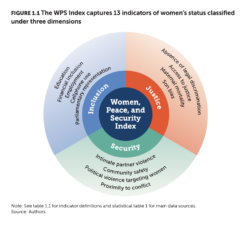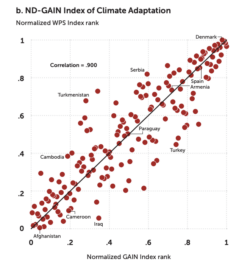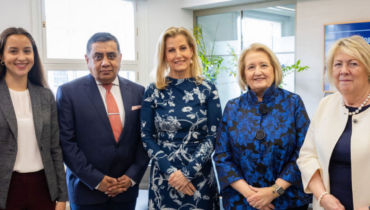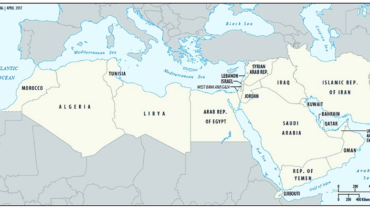Around the world, health crises, violent conflict, political unrest, and climate change have exacerbated economic difficulties, destroyed social infrastructures, and magnified gender inequalities. The advancement of women’s rights lies at the center of all human development and prosperity, and is vital in envisioning, building, and strengthening a more peaceful world.
The 2023/24 Women, Peace and Security Index, the fourth edition since 2017, scores and ranks 177 countries in terms of women’s status. The WPS Index captures 13 indicators of women’s status classified and scored under the three dimensions of women’s inclusion, justice, and security, and is the only index to bring these elements together.

This year’s Index is a valuable tool for policymakers, nations, and international bodies to not only track the status of women worldwide, but also guide and implement just and accountable protections.
The results highlight drastic disparities in women’s status globally. Altogether, the WPS Index reminds us that complete inclusion, justice, and security are fundamental in promoting and upholding a universal vision of women’s peace and security. Below are the top five takeaways from this year’s results.
- Developed Countries lead the rankings, as Fragile States trail behind
Denmark ranks first this year, scoring more than three times higher than Afghanistan at the bottom. At the regional and country group level, Developed Countries and Central & Eastern Europe & Central Asia perform best on average. Eight of the bottom dozen are from Sub-Saharan Africa. Conflict and instability exacerbate gender divisions, with eleven of the bottom dozen countries classified as Fragile States. Since the first WPS Index in 2017, Afghanistan, Democratic Republic of Congo (DRC), Iraq, Syria, and Yemen have remained among the bottom dozen ranked nations.
Within regions, the Middle East & North Africa (MENA) displays the widest variation, with the UAE ranking 22nd and Yemen ranking 176th. Countries in this group perform comparatively worse within the justice dimension, and often struggle to provide —— and construct —— equitable, supportive legal frameworks for women. Overall, MENA reports the highest levels of legal discrimination and access to justice, as well as the lowest rates of women’s employment and political representation in the world, signaling a long journey towards obtaining true gender equity.

- Women’s status is strongly correlated with global development, climate, peace
The WPS Index is strongly correlated with several other indices that rank countries in terms of global development, climate change preparedness, resilience, and peace. For example, the 2023 Index is highly correlated with the Fund for Peace’s State Resilience Index, signifying that countries where women prosper tend to have lower risk of conflict or crisis. The WPS Index is also strongly associated with the Notre Dame Global Adaptation Initiative (ND-GAIN) Index, which measures countries’ preparedness to respond to the impacts of climate change. Findings show that countries where women are doing well tend to be less vulnerable to environmental threats, and more focused on prioritizing climate solutions. These correlations conclude that women must be central figures in addressing and overcoming conflict and crisis, and that calling for women’s peace and security is critical in strengthening broader societies.


- Subdimensional performance varies within country borders
Within country borders, several nations display variation across different measures of women’s status. Those that excel in terms of women’s physical safety may fall short in supporting their access to education, or vice versa. For example, Vietnam ranks among the top 25 countries globally within the security dimension, but falls to the bottom 25 in terms of justice. These observations signify the complexity of women’s rights, and remind us that progress within countries is neither uniform nor linear. All countries have room for improvement, and their overall performance only captures a snapshot of each individual context. The Index’s multidimensional framework provides a foundation for policymakers to identify where women are facing particular disadvantages through understanding the state of inclusion, justice, and security, both separately and together.
- Physical, digital forms of political violence increasingly target, silence, and marginalize women
Political violence against women is a growing phenomenon worldwide, and serves to deter, silence, and prevent women from meaningfully participating in civic spaces and leadership roles. Women politicians, journalists, activists, and civilians alike face threats of attack on their person and character, which bolsters democratic backsliding and threats to national security. Forms of political violence range from physical violence—including sexual and non-sexual assaults—to technology-facilitated gender based violence, which manifests in digital attacks and misinformation campaigns to undermine prominent women’s platforms or silence their voices.
Reflecting on political violence’s threat to women, peace and security, this year’s Index introduces a new Political Violence Targeting Women (PVTW) indicator within the security dimension. Using data from the The Armed Conflict Location & Event Data Project (ACLED), this indicator measures the number of PVTW events per 100,000 women in each country. Data revealed that Mexico, Brazil, Nigeria, the Democratic Republic of Congo, and Myanmar had the most PVTW events in 2022. On the regional level, Fragile States displayed the highest PVTW event count at 1,320 events, followed by Latin America and the Caribbean (with 1,212), and Sub-Saharan Africa (with 924). These findings present the common co-presence of social instability and regional conflict alongside gendered insecurity, reinforcing the precedence of women’s safety before their ability to freely and equally participate.

- Negative correlation between proximity to conflict and WPS score, Index reveals
The third chapter of this year’s Index spotlights the experiences of women in conflict-ridden states, and delves deeper into subnational analyses of Colombia and Ethiopia. Recognizing that 2022 was the deadliest year in terms of battle deaths from armed conflict since 1994, the chapter broadly focuses on the effects of political and social instability on the deterioration of women’s rights. Ultimately, the findings show that all 20 bottom-ranking countries experienced armed conflict between 2021 and 2022. In most of these, more than half of the female population live within 50 kilometers to conflict events, and overall, roughly 600 million women worldwide live in close proximity to armed conflict. Regional and group-level disparities are distinct, and the share of women at risk ranges from less than one percent in Developed Countries to 61 percent in Fragile States. Latin America and the Caribbean and Sub-Saharan Africa have the second and third highest levels at 44 and 37 percent, respectively.


